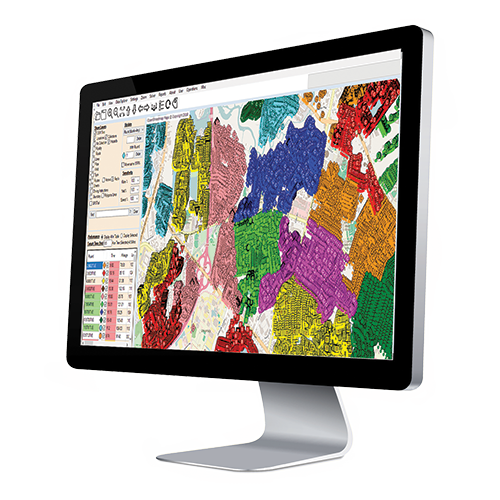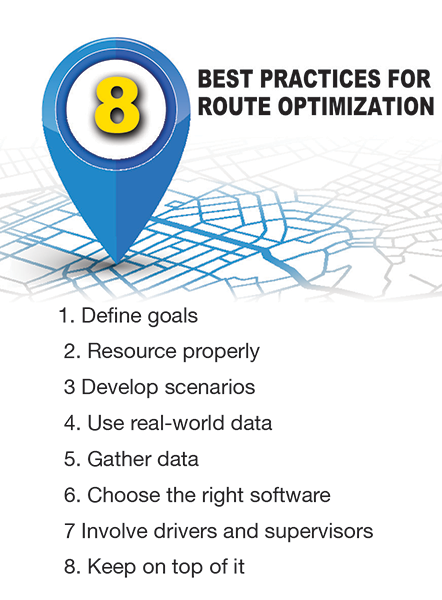Given the growing number of changes in solid waste—and the speed at which they are happening—the days of one-and-done route optimization are past. Today’s forward-thinking organizations are working toward increased agility and resilience within a continuous improvement model that relies on a sustained feedback loop to inform and transform route plans over time.
By Calum Forsyth
Route design used to be a task municipal and private haulers undertook a handful of times over the course of their careers. As these planned routes evolved, longtime drivers absorbed the changes, and together with their supervisors and managers, the team just made things work—often with the aid of paper-based maps, a whiteboard, and a few hours spent in the conference room.

More and more frequent changes, however, now influence solid waste collection and highlight the need for a better and more iterative route design process. These changing influences span the full breadth of solid waste management to include the municipal solid waste profile, collection streams, population and household makeup, vehicle fleets, customer expectations, and, of course, funding.
For many haulers, route inefficiencies brought about by such changes have crept in bit by bit over several years. Now, the pandemic and its continued fallout are bringing route inefficiency into its sharpest focus yet.
With a driver shortage, skyrocketing fuel prices, and increasing environmental reporting demands hammering municipalities and haulers, the time to design efficient routes and develop a plan for continuous improvement in relation to route efficiency was yesterday. The second-best time, as the saying goes, is today. Route optimization software can help.
Indeed, when private hauler Meridian Waste, headquartered in Charlotte, NC undertook route optimization in one of its markets, it realized a number of benefits. They freed up 34 percent of solid waste vehicles and eliminated 26 percent of trash routes while reducing route miles and related emissions by 21 percent. Another plus: they were able to phase out aging collection vehicles without the need to replace them.
Certainly, route optimization can be worthwhile—with savings ringing in at 10 to 15 percent across such projects. With so much at stake, it is worth following best practices to nail it the first time.

Images courtesy of Routeware.
#1: Define Goals
Do you want to balance routes and workloads, deliver better service, or reduce your number of trucks? Or perhaps you are changing collection frequency, adding new services, or consolidating routes following a merger or acquisition.
As a growing company making regular acquisitions, Meridian Waste provides residential, municipal, and commercial hauling, plus roll-off, special waste, and construction/demolition services. When the company acquires new routes, it uses route optimization software from EasyRoute to streamline collections. As Patrick Messinger, Area President for South Carolina, put it, “EasyRoute was a key pivot for us. We’ve used it in all our markets to help us hit our goals.”
Defining the outcomes you seek, as well as their priority, will allow you to scope and resource the project properly before you begin.
#2: Resource Properly
Once you have defined goals for your route optimization project and scoped appropriately, it is important to resource the project properly. Ideally, one person can take ownership of the project and software. This person can coordinate teams, keep projects on track, and make sure you have the modeling data you need.
If you can dedicate someone to this role and make the project their primary responsibility, the process of route planning is apt to run much more quickly and smoothly. Regardless of the size of your team, taking a realistic view of available resources at the outset will help you build an achievable timeline with milestones that energize team members and help keep the momentum going—all the way to the finish line.
#3: Develop Scenarios
Of course, making the most of resources is at the heart of optimization. Placing the right trucks and drivers in the right places at the right times delivers the efficiencies that make undertaking route redesign worthwhile.
By starting with a set of core scenarios, and their unique dependencies, you can use route optimization software to test each one and determine exactly what resource will be needed to deliver.
If you take the time to develop these test scenarios with real-world data, the optimized results will be quicker to evaluate. In addition, you will avoid rework as different requirements present themselves.
With its IT Manager for the Division of Waste Management, Eddie Dean, at the helm, the City of Lexington, KY was able to reroute collections of 360,000 carts across garbage, recycling and yard waste streams in just three months with route optimization software. By planning and resourcing properly, and selecting the right tool, Dean and his team saved considerable time on a project that previously would have taken two years.
#4: Use Real-World Data
Speaking of real-world data: a worthwhile route design process needs it. Without real data inputs, the outputs of optimization will be guesses, whether you are working with pen and paper or software.
The advantage of using software, of course, is its ability to quickly crunch these real inputs from multiple sources, such as GPS and in-vehicle systems. It is important to note that while input data does not need to be perfect or absolutely complete, it must be real for the resulting plans to be realistic and achievable.
#5: Gather Data
This real-world data will include inputs such as address lists, container details, current routes, access issues, facility details, and material weights. Input data is so important, in fact, you should plan to spend about one-third of total project time gathering this information. Defining the data you need, creating a plan for collecting it, and then doing the collection are all critical tasks for a successful reroute project. It is hard to overstate the importance of this, so we will say it again: plan to spend enough time gathering robust, real-world input data. You will be glad you did.
#6: Choose the Right Software
It is worth noting: routing solutions from other industries do not work in waste. The optimization of solid waste collection routes is different and more complex than routing problems in other industries, such as deliveries or field service. It involves many more stops, different frequencies of collection, specific safety risks, and unusual vehicle constraints.
While solid waste route optimization is complex, with the right software and support, it is worthwhile—and results from successful projects in cities around the world prove it. The City of Virginia Beach, the most populous city in Virginia—which provides household garbage, recycling and yard waste collection services—reduced its number of routes by 10 percent in phase two of a three-phase route optimization project. The City also reduced operating costs due to fewer miles traveled and fewer trips to the landfill, and enhanced safety protocols for busy and tight spaces.
#7: Involve Drivers and Supervisors
Route optimization software empowers people who understand waste collection to design better routes faster, so it is imperative that drivers and supervisors be involved in the route design process. In no way does this software replace people—and it certainly does not replace the deep knowledge of those who operate solid waste
services. On the contrary, it is simply a power tool for its users. When knowledgeable users leverage robust software tools for route optimization, the resulting designs just work.
#8: Keep on Top of It
Given the growing number of changes in solid waste—and the speed at which they are happening—the days of one-and-done route optimization are past. Today’s forward-thinking organizations are working toward increased agility and resilience within a continuous improvement model that relies on a sustained feedback loop to inform and transform route plans over time.

As the solid waste landscape continues to shift, agility is becoming more important for organizations with environmental targets to meet. As populations grow, new collections are added and others are removed, collection weights go up and down, and crew and fleet makeup changes over time, solid waste operators who commit to keeping data up-to-date in a continuous fashion will realize the greatest efficiencies in their operations while saving money for their organizations. In turn, these agile leaders who plan for the future will help make a lasting impact for operations and the environment. | WA
Calum Forsyth is an Executive Director at Routeware, a leading provider of cloud-based technology solutions including route optimization software for the waste and recycling sector. He can be reached at [email protected].
